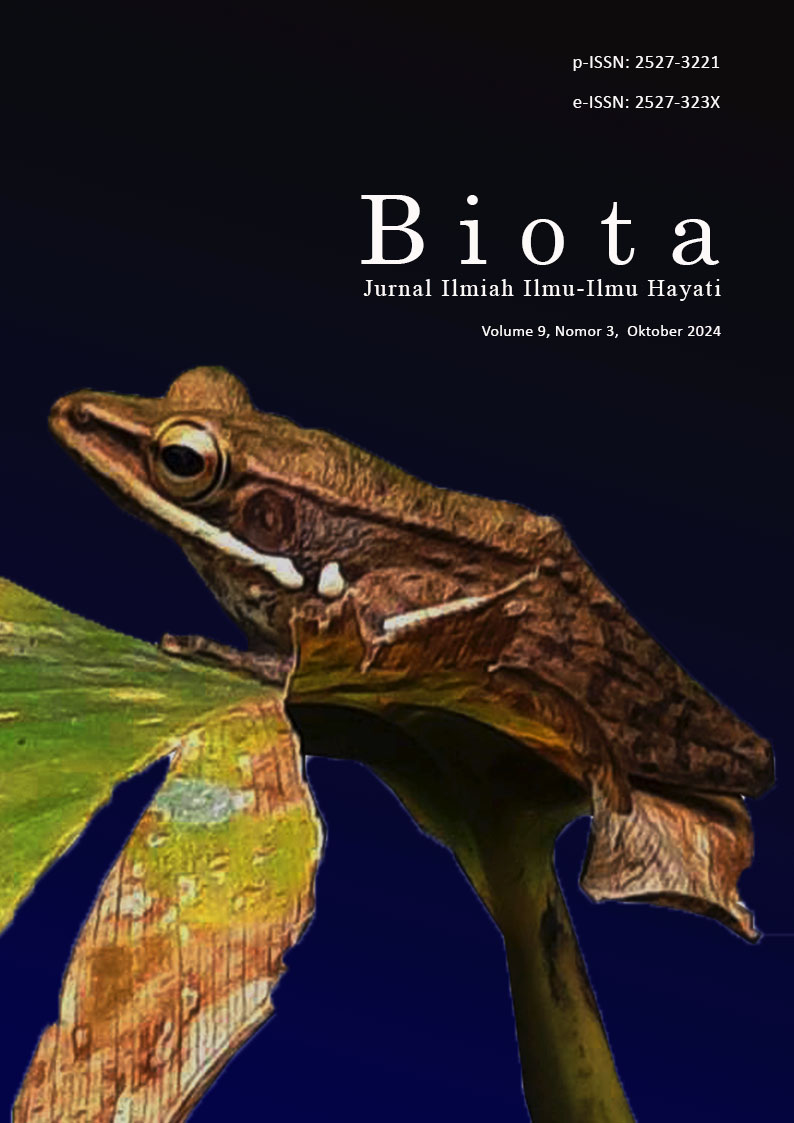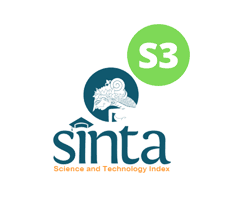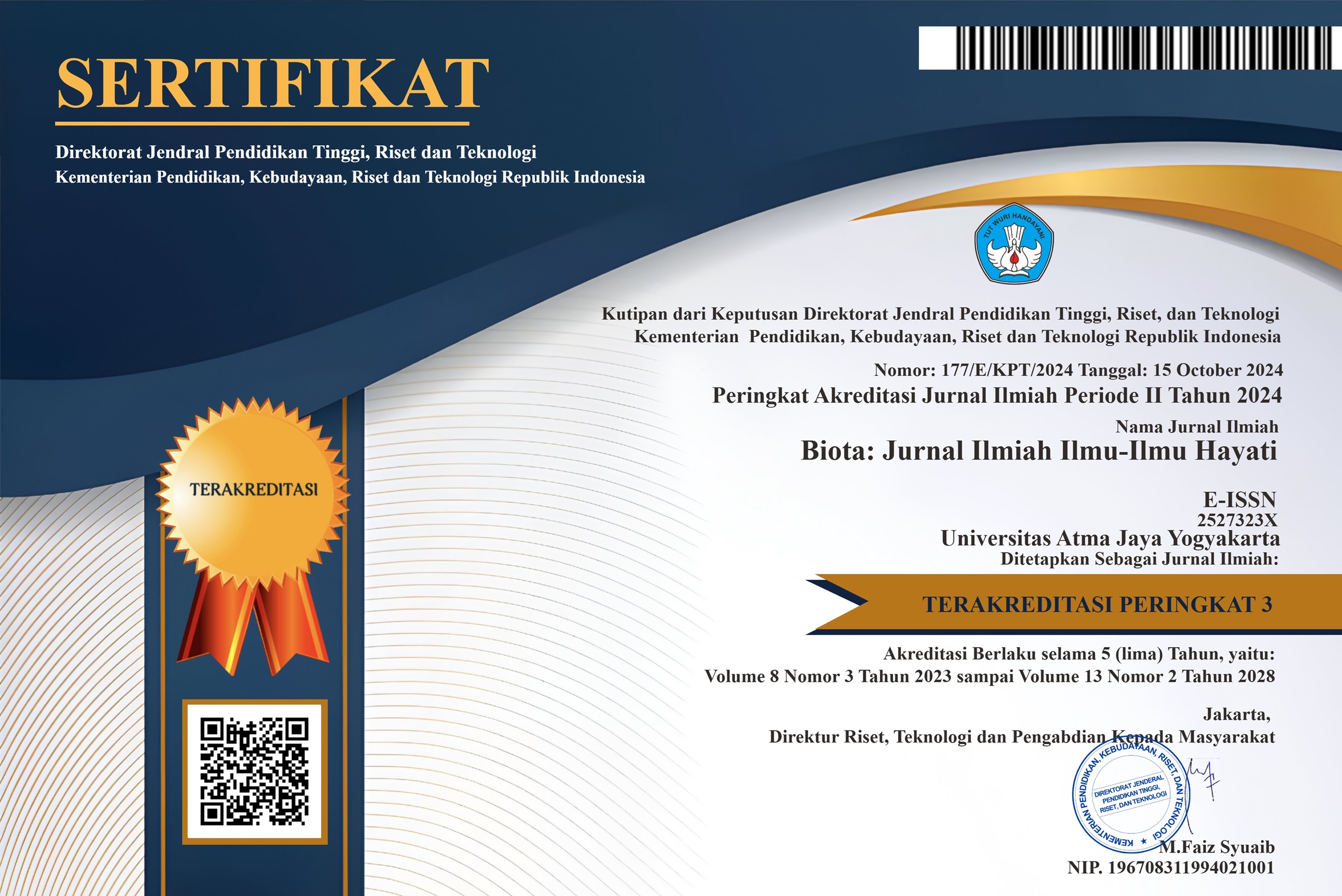Intensitas Cahaya pada Perkecambahan Benih dan Pertumbuhan Semai Cabai Merah Landung (Capsicum annuum cv. Landung)
DOI:
https://doi.org/10.24002/biota.v9i3.8359Keywords:
Cabai merah, intensitas cahaya, kecepatan pertumbuhan, naungan, persemaianAbstract
Cabai Merah (Capsicum annuum L.) biasanya ditanam di pembibitan sebelum dipindahkan ke lahan. Informasi mengenai lingkungan optimal, termasuk intensitas cahaya, penting untuk memproduksi bibit cabai berkualitas. Penelitian bertujuan mengetahui pengaruh intensitas cahaya, berdasarkan jenis atap persemaian (paranet kerapatan 25%, 50%, dan 75%, kaca, dan fiberglass), terhadap perkecambahan dan pertumbuhan bibit cabai cv. Landung. Penelitian menggunakan Rancangan Kelompok Lengkap Teracak (RKLT) dengan empat ulangan. Hasil penelitian menunjukkan intensitas cahaya mempengaruhi perkecambahan dan pertumbuhan bibit cabai merah secara keseluruhan. Benih yang memperoleh intensitas cahaya lebih tinggi, yakni di bawah atap kaca (13.876,67 lux) dan atap fiberglass (16.268,89 lux) berkecambah lebih awal dan lebih seragam, dan menghasilkan persentase perkecambahan akhir lebih tinggi (97% dan 95%) dibandingkan benih yang memperoleh intensitas cahaya lebih rendah (atap paranet dengan kerapatan 25%, 50%, dan 75%), masing-masing sebesar 90%, 80,5%, dan 73,2%. Pertumbuhan bibit cabai merah di bawah atap kaca dan fiberglass lebih vigor sehingga menghasilkan kecepatan pertumbuhan (R) lebih tinggi (7,25 dan 7,49) dibandingkan semua perlakuan paranet (7,74, 7,74, dan 7,62). Bahan atap persemaian perlu dipertimbangkan sebab mempengaruhi perkecambahan dan pertumbuhan bibit cabai dengan mempengaruhi intensitas cahaya, seperti ditunjukkan oleh penelitian ini.
References
Ajis, A., & Harso, W. (2020). Pengaruh intensitas cahaya matahari dan ketersediaan air terhadap pertumbuhan tanaman cabai rawit (Capsicum frutescens l.). Biocelebes, 14(1), 31–36. https://doi.org/10.22487/bioceb.v14i1.15084
Al-Helal, I., & Abdel-Ghany, A. (2010). Responses of plastic shading nets to global and diffuse PAR transfer : Optical properties and evaluation. NJAS - Wageningen Journal of Life Sciences, 57(2), 125–132. https://doi.org/10.1016/j.njas.2010.02.002
Arta, I. M. W. G., Sumiyati, & Madrini, I. A. B. (2019). Analisis profil iklim mikro pada budidaya cabai rawit (Capsicum frutescens L) menggunakan bahan sungkup plastik, paranet dan kombinasi. Jurnal Beta (Biosistem Dan Teknik Pertanian), 7(1). https://ojs.unud.ac.id/index.php/beta
Aulia, M. F., Rokhmat, M., & Qurthobi, A. (2020). Analisa pengaruh intensitas cahaya terhadap pertumbuhan bibit tanaman cabai dalam ruangan tertutup dengan kelembaban tetap. E-Proceeding of Engineering, 7(2), 4263.
BPS, [Badan Pusat Statistik]. (2022). Distribusi Perdagangan Komoditas Cabai Merah di Indonesia 2022. BPS RI.
De Wit, M., Galvão, V. C., & Fankhauser, C. (2016). Light-Mediated Hormonal Regulation of Plant Growth and Development. Annual Review of Plant Biology, 67, 513–537. https://doi.org/10.1146/ANNUREV-ARPLANT-043015-112252
Debbarma, A., Devi, J., Barua, M., & Sarma, D. (2018). Germination performance of chilli (Capsicum annuum L.) and coriander (Coriandrum sativum L.) as affected by seed priming treatments. Journal of Pharmacognosy and Phytochemistry, 7(1), 2648–2652.
Despiani, L. (2012). Pengaruh intensitas cahaya terhadap pertumbuhan dan produksi tanaman bangun-bangun (Coleus amboinicus Lour). IPB University.
Dias, L. S., Ganhão, E., & Dias, A. S. (2020). Responses of germination to light and to far-red radiation—can they be predicted from diaspores size? Data, 5(2). https://doi.org/10.3390/data5020049
Famela Saskia, Rizki, & Rina Alfina. (2023). Pengaruh pemberian pupuk KNO₃, Boron, dan MKP terhadap pertumbuhan cabai hias pelangi (Capsicum Annum L.) Var. Bolivian Rainbow. Atech-i, 1(1), 16–24. https://doi.org/10.55043/atech-i.v1i1.11
Fitter, A. H., & Hay, R. K. M. (1992). Environmental physiology of plants (E. D. P. and B. S. “Fisiologi L. T. Translated by Sri Andani, Ed.). Gadjah Mada University Press.
Gardner, F. P., Pearce, R. P., & Mitchell, R. L. (1991). Physiology of crop plants (Translated by Herawati Susilo and Subiyanto “Fisiologi Tanaman Budidaya,” Ed.). UI press.
Haryadi, R., Evie Setia Asih, E., Siti Masitoh, E., Nurfarihah Afriyanti, I., Dwi Anggriani, N., & Wijayanti, F. (2017). Karakteristik cabai merah yang dipengaruhi cahaya matahari. Gravity: Jurnal Ilmiah Penelitian Dan Pembelajaran Fisika, 3(1). http://jurnal.untirta.ac.id/index.php/Gravity
Haryanti, S., & Budihastuti, R. (2015). Morfoanatomi, berat basah otiledon dan ketebalan daun kecambah kacang hijau (Phaseolus vulgaris L.) pada naungan yang berbeda. Buletin Anatomi Dan Fisiologi, XXIII(1), 47–56.
International Seed Testing Association. (2015). Seed Testing International (B. Kufman, R. El-Khadem, P. Muschick, & J. Taylor, Eds.; Issue 147). International Seed Testing Association.
ISTA. (1976). III. Seed Moisture Content. https://www.bioversityinternational.org/fileadmin/bioversity/publications/Web_version/188/ch05.htm
Kamaliah, T. L., Hidayat, P., Maharijaya, A., & Syukur, M. (2022). Preferensi Bemisia tabaci Genn . dan Kaitannya dengan Karakter Anatomi dan Morfologi Daun pada Cabai ( Capsicum annuum L .) Preference Bemisia tabaci Genn . and Its Relation to Leaf Anatomical and Morphological Characters of Chili ( Capsicum annuum L .). Jurnal Agronomi Indonesia, 50(3), 291–298.
Karunarathna, D., Ratnayake, U. N., & Hemamali, U. (2021). The effect of light intensity on seed germination and early seedling development of chilli plant ( Capsicum annuum L.). Young Scientists Conference on Multidisciplinary Research-2021, 7–15.
Kementerian Perdagangan Republik Indonesia. (2021). Analisis Perkembangan Harga bahan Pangan pokok di Pasar Domestik dan Internasional. Kementerian Perdagangan Republik Indonesia.
Khadijeh, S., Zare, A., Sedaghathoor, S., Dahkaei, N. P., & Hashemabadi, D. (2019). The effect of light variations by photoselective shade nets on pigments , antioxidant capacity , and growth of two ornamental plant species : Marigold ( Calendula officinalis L .) and violet ( Viola tricolor ) The effect of light variations by photoselect. Cogent Food & Agriculture, 5(1), 1650415. https://doi.org/10.1080/23311932.2019.1650415
Lestari, P. (2021). Not just a spice, this is another function of capsaicin in chilies during a pandemic. Biotrends, 12(1), 10–15.
Lestari, P., Utami, N. W., & Wawo, A. H. (2019). Adaptasi intensitas cahaya rendah gembili ( Dioscorea esculenta ) pada naungan artifisial Adaptation on low light intensity of lesser yam ( Dioscorea esculenta ) under artificial shading. Pros Sem Nas Masy Biodiv Indon, 5, 374–382. https://doi.org/10.13057/psnmbi/m050241
Lestari, P., Utami, N. W., Wawo, A. H., Botani, B., Penelitian, P., Lipi, B. –, Raya, J., & Km, J.-B. (2012). Adaptasi Aksesi Kentang Hitam {Plectranthus rotundifolius (Poir.) Spreng} Tterhadap berbagai Intensitas cahaya. Berita Biologi, 11(3), 351–358.
Liu, X., Shi, R., Gao, M., He, R., Li, Y., & Liu, H. (2022). Effects of LED light quality on the growth of pepper (Capsicum spp.) seedlings and the development after transplanting. Agronomy, 12(10). https://doi.org/10.3390/agronomy12102269
Lozada, D. N., Bosland, P. W., Barchenger, D. W., Haghshenas-Jaryani, M., Sanogo, S., & Walker, S. (2022). Chile Pepper (Capsicum) Breeding and Improvement in the “Multi-Omics” Era. Frontiers in Plant Science, 13(May). https://doi.org/10.3389/fpls.2022.879182
Melta, A. A., Yulianty, Y., Agustrina, R., Setiawan, W. A., Suratman, S., & Chrisnawati, L. (2022). Pertumbuhan Benih Cabai (Capsicum annuum L.) dengan Induksi Medan Magnet 0.2 mT dan Infeksi Fusarium oxysporum. Biota Jurnal Ilmiah Ilmu-Ilmu Hayati, 7(2), 151–159. https://doi.org/https://doi.org/10.24002/biota.v7i2.4731
Nand Dubey, A., Puri Goswami, S., & Kumar Devedee, A. (2018). Effect of temperature on different growth stages and physiological process of rice crop-as a review. Bulletin of Environment, Pharmacology and Life Sciences, 168–169. https://www.researchgate.net/publication/339090117
Nurul Laili, F., Kurniastuti, T., & Puspitorini, P. (2020). Respon pertumbuhan dan hasil tanaman cabai merah (Capsicum annum Var. Longun L.) terhadap pemberian dosis pupuk NPK dan bokashi. VIABEL: Jurnal Ilmiah Ilmu-Ilmu Pertanian, 14(1), 37–43. https://doi.org/10.35457/viabel.v14i1.999
Okunlola, G. O., Olatunji, O. A., Akinwale, R. O., Tariq, A., & Adelusi, A. A. (2017). Physiological response of the three most cultivated pepper species (Capsicum spp.) in Africa to drought stress imposed at three stages of growth and development. Scientia Horticulturae, 224(July 2017), 198–205. https://doi.org/10.1016/j.scienta.2017.06.020
Rahmawati, D., Supriyanto, & Nugroho, A. (2022). Pengaruh radiasi sinar gamma terhadap daya kecambah benih akasia (Acacia mangium) genrasi M2. Jurnal Perbenihan Tanaman Hutan, 10(1), 23–36.
Ritonga, A. W., Chozin, M. A., Syukur, M., Maharijaya, A., & Sobir. (2018). Short communication: Genetic variability, heritability, correlation, and path analysis in tomato (Solanum lycopersicum) under shading condition. Biodiversitas, 19(4), 1527–1531. https://doi.org/10.13057/biodiv/d190445
Rosmaina, R., Parjanto, P., Sobir, S., & Yunus, A. (2019). Screening of capsicum annuum L. Genotypes for drought tolerance based on drought toleranc indices. Sabrao Journal of Breeding and Genetics, 51(3), 205–224.
Sahid, Z. D., Syukur, M., Maharijaya, A., & Nurcholis, W. (2021). Polyphenol content and pharmacological activities of capsicum frutescens and c. Chinense genotypes. Biodiversitas, 22(9), 3838–3843. https://doi.org/10.13057/biodiv/d220929
Sahid, Z. D., Syukur, M., Maharijaya, A., & Nurcholis, W. (2023). Total phenolic and flavonoid contents, antioxidant, and α-glucosidase inhibitory activities of several big chili (Capsicum annuum L.) genotypes. Ciencia Rural, 53(7), 1–8. https://doi.org/10.1590/0103-8478cr20210913
Salisbury, F. B., & Ross, C. W. (1995). Fisiologi tumbuhan (R. L. dan Sumaryono. "Fisiologi T. P. T. dan F. Lingkungan. Translated by Diah, Ed.; Edition 3). ITB Press.
Sanjuan-Martínez, J., Ortiz-Hernández, Y. D., Aquino-Bolaños, T., & Cruz-Izquierdo, S. (2020). Seed and seedling quality of three chilis (Capsicum annuum l.) native to Oaxaca, Mexico. Ciencia Rural, 50(9), 1–10. https://doi.org/10.1590/0103-8478cr20190921
Scientific Engineering Response and analytical Services. (1994). Standard Operating Procedures. Plant biomass determination. https://clu-in.org/download/ert/2034-r00.pdf
Selvia, S., Indah Amelia Jupani, Dea Sartika, Indayana Febriani Tanjung, & Febry Ramadhani. (2023). Pengaruh pemberian air, MSG (Monosodium Glutamate) dan garam NaCl terhadap pertumbuhan dan perkembangan tanaman cabai (Capsicum Annuum L.). Jurnal Pendidikan Mipa, 13(1), 10–15. https://doi.org/10.37630/jpm.v13i1.798
Sitompul, S. M., & Guritno, B. (1995). Analisis pertumbuhan tanaman. Gadjah Mada University Press .
Sudomo, A. (2009). Pengaruh naungan terhadap pertumbuhan dan mutu bibit (Manglieta glauca BI). Tekno Hutan Tanaman. Tekno Hutan Tanaman, 2(2), 59–66.
Susenas. (2021, September). Konsumsi cabai merah besar di Indonesia (2017-2021). Survei Sosial Ekonomi Nasional (Susenas) September 2021. https://databoks.katadata.co.id/datapublish/2022/10/26/konsumsi-cabai-merah-meningkat-994-pada-2021
Syarif, F., Hidayati, N., & Lestari, P. (2023). Low-dose gamma radiation accelerates the adaptation of foxtail millet [Setaria italica (L.) P. Beauv] accession to shade environment. The 8th International Symposium of Innovative Bio-Production Indonesia on Biotechnology and Bioengineering (ISIBio-8) 2021, 1, 040009. https://doi.org/https://doi.org/10.1063/5.0118418
Tripathi, S., Hoang, Q. T. N., Han, Y. J., & Kim, J. Il. (2019). Regulation of Photomorphogenic Development by Plant Phytochromes. International Journal of Molecular Sciences, 20(24). https://doi.org/10.3390/IJMS20246165
Utari, D., & Rachmawati, D. (2022). Respons pertumbuhan dan kadar kapsaisin tanaman cabai merah (Capsicum annuum L.) terhadap kekeringan dan pemberian Mikoriza Arbuskular. Vegetalika, 11(1), 63–77. https://doi.org/10.22146/veg.66916
Wei, Y., Wang, S., & Yu, D. (2023). The Role of Light Quality in Regulating Early Seedling Development. Plants, 12(2746), 1–15. https://doi.org/10.3390/plants12142746
Wille, W., Pipper, C. B., Rosenqvist, E., Andersen, S. B., & Weiner, J. (2017). Reducing shade avoidance responses in a cereal crop. AoB PLANTS, 9(5). https://doi.org/10.1093/aobpla/plx039
Zhen, S., van Iersel, M. W., & Bugbee, B. (2022). Photosynthesis in sun and shade the surprising importance of far‐red photons. New Phytologist, 236, 538–546. https://doi.org/10.1111/nph.18375 Key
Downloads
Published
How to Cite
Issue
Section
License
Copyright (c) 2024 Albertus Husein Wawo, Peni Lestari, Ninik Setyowati, Indra Gunawan, Frisca Damayanti, Nur Kholidah

This work is licensed under a Creative Commons Attribution-NonCommercial 4.0 International License.
Authors who publish with Biota : Jurnal Ilmiah Ilmu-Ilmu Hayati agree to the following terms:
- Authors retain copyright and grant the Biota : Jurnal Ilmiah Ilmu-Ilmu Hayati right of first publication. Licensed under a Creative Commons Attribution-NonCommercial 4.0 International License that allows others to share the work with an acknowledgment of the work's authorship and initial publication in this journal.
- Authors are able to enter into separate, additional contractual arrangements for the non-exclusive distribution of the journal's published version of the work (e.g., post it to an institutional repository or publish it in a book), with an acknowledgment of its initial publication in Biota : Jurnal Ilmiah Ilmu-Ilmu Hayati, and as long as Author is not used for commercial purposes.













